What I learned from playing through Dragon's Lair Trilogy: Don Bluth really liked drawing women with REALLY pointy nipples.
Dragon's Lair Trilogy Review
|
|
See PixlBit's Review Policies

On 12/01/2010 at 03:15 PM by Chessa DiMola A great compilation of three classic titles. |

For the nostalgic gamer and fans of Dragon's Lair.
Sometimes game releases come about, not to offer the latest innovative experience, but rather to pay homage to our roots. Dragon's Lair Trilogy is one such example, and though similar gameplay would label a game broken or unplayable by modern standards, it showcases just how far we have come in 27 years.
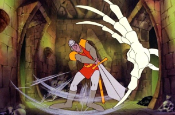
For those who don't know, Dragon's Lair was an incredibly innovative title for its time. Released in 1983, its graphics and gameplay rivaled anything found on home consoles or in arcades at the time. Unlike other games of its era, Dragon's Lair was able to overcome the hardware limitations of its competitors by using laserdisc technology. This enabled developers to drastically improve the graphical experience, which at the time was limited to extremely low resolution sprites. Without that issue present, Dragon's Lair was entirely animated from beginning to end by Don Bluth; an ex-Disney animator known for his work in many popular animated films, such as Sleeping Beauty, Robin Hood, and The Sword in The Stone.
Unfortunately, due to the incredible popularity of the arcade title, the hardware was often pushed beyond its capabilities, leading to widespread breakdowns of the cabinet units. Between the cost of fixing the units, and keeping the disc lens clean, Dragon's Lair was ultimately removed from arcades.
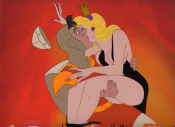
Since then, the title has been released on nearly every single home console to ever exist. Some versions tweaked the original formula slightly, while others adhered quite closely to the primary vision. The latest edition, Dragon's Lair Trilogy for Wii, includes the original version of Dragon's Lair, along with two other titles: Dragon's Lair II: Time Warp and Space Ace.
The original Dragon's Lair stars Dirk the Daring in an epic quest to save Princess Daphne from her dragon captor, Singe. In order to do so players must make their way through a castle riddled with dozens of different enemies and hazards. As players will quickly notice during the fifteen minute experience, many sections of the level will repeat, although the rooms seem to be mirror images of one another the second time around.

The gameplay is very simple; players merely watch for on-screen cues in the form of up, down, left, right, or attack, and hit the correct button or direction when appropriate. Though it may sound easy, the experience is anything but smooth, for in one instance players will have plenty of time to react, whereas in others they must be prepared ahead of time. Unlike its arcade forefather, players are able to set their own number of extra lives with Dragon's Lair Trilogy, including the option to have unlimited retries. Though some will undoubtedly love the challenge created by having limited lives, being able to enjoy the classic experience without concern is greatly appreciated.
The second title included, Dragon's Lair II: Time Warp, is technically not the original sequel to Dragon's Lair, though it is regarded by many as the "true" sequel. In Dragon's Lair II, Princess Daphne, now the wife of Dirk the Daring, is once again kidnapped, this time by the evil wizard Mordrock, who wishes to force Daphne into marrying him. Unlike its predecessor, which took place solely within a castle, Dragon's Lair II takes players through several different times and dimensions, many with popular fairy tale themes, such as Alice in Wonderland.
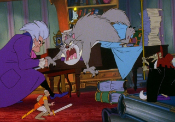
Though the gameplay and art style are identical to its predecessor, Dragon's Lair II is quite a bit more engaging. This is most likely due to the fact that the sequences smoothly transition from one to the next, giving the player a true sense of controlling an interactive story. For prior fans of Dragon's Lair II, there is an alternate ending included with the trilogy.
The final title, Space Ace, is the second laserdisc arcade title produced by Don Bluth to be released, back in 1984. The story features the character Ace, a muscular space hero who has been zapped by the main villain, Borf, with an Infanto Ray; a weapon that transforms Ace into a much younger version of himself, known as Dexter. After attacking Ace, Borf kidnaps his girlfriend Kimberly, and it is up to Ace/Dexter to rescue Kimberly and save Earth from Borf's Infanto Ray.

As with the other two titles featured in Dragon's Lair Trilogy, the gameplay in Space Ace revolves around responding to on-screen directional cues, though there is one main difference. In Space Ace, players are able to switch between Ace and his younger self, Dexter, in order to navigate certain sections of a level; however they don't necessarily have to make the switch in order to be successful. Ace and Dexter merely have different ways of handling a situation. Ace will usually be more combat-oriented, whereas Dexter's path will mostly consist of avoiding obstacles.
Despite the unique aspects of Space Ace, I found it to be the least entertaining of the titles included within Dragon's Lair Trilogy. The action was as quick as that found in Dragon's Lair II but the whole experience seemed a bit too hectic and disjointed to keep me interested.
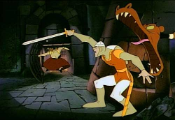
For those not interested in actually playing the game, and wish to purchase the title merely for reasons of video game nostalgia, an option to simply watch each of the three included titles is available.
Though these games are sorely outdated for the current times, having them together in one well-done package is something that long-time gamers have desired for years. These are the games the way they were originally meant to be played, without being tweaked to meet technical limitations, or "improved" upon. While only a small percentage of gamers may truly be able to appreciate the titles contained within Dragon's Lair Trilogy, those who do see the worth in such a collection won't be disappointed.








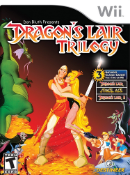


Comments